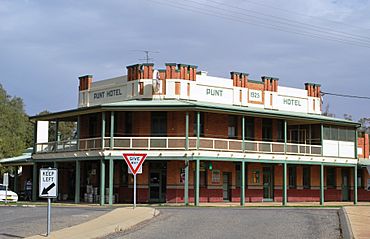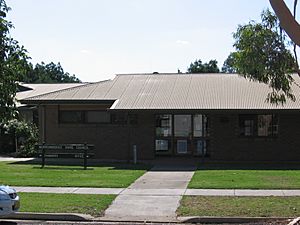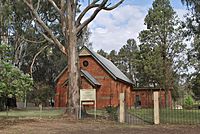Darlington Point facts for kids
Quick facts for kids Darlington PointNew South Wales |
|
|---|---|

The Punt Hotel
|
|
| Population | 1,030 (2021 census) |
| Postcode(s) | 2706 |
| Location |
|
| LGA(s) | Murrumbidgee Council |
| County | Cooper |
| State electorate(s) | Murray |
| Federal Division(s) | Riverina |
Darlington Point is a friendly town in western New South Wales, Australia. It sits right on the banks of the Murrumbidgee River. This town is part of the Murrumbidgee Council area.
You can find Darlington Point about 631 kilometres (392 miles) south-west of Sydney. It's also just 33 kilometres (20 miles) south of Griffith. In 2021, about 1,030 people lived here.
Contents
Discovering Darlington Point's Past
Early Days and River Crossings
The land around Darlington Point was first used for farming in 1844. A man named John Peter started a large farm called "Cuba". He also had another farm called "Tubbo" on the other side of the river.
The spot where the town now stands was a popular crossing point. People used it to move their animals and goods across the Murrumbidgee River.
How Darlington Point Grew
In 1864, a man named George Rogers built the first inn, called the Darlington Inn. It was near the river crossing. Soon, another hotel opened on the south side of the river. This area became known as Waddai.
By 1865, both sides of the river were growing. There were two hotels, one on each bank. In 1866, a large punt was brought in. A punt is like a big flat boat used to ferry people, animals, and wagons across a river. This punt could carry 1,700 sheep at once!
Over time, more hotels and stores opened. The town started to get important services like a post office in 1876. A school opened in 1882. Soon, there was also a courthouse, police station, and telegraph service.
Even though there were two settlements, the name 'Darlington Point' eventually became used for both. The main street in town is still called Punt Road, reminding everyone of the old river ferry.
In 1905, a special lift bridge was built to connect the two sides of the river. This made crossing much easier! A new concrete bridge replaced it in 1979. You can still see a part of the old bridge at the entrance to the Darlington Point Riverside Caravan Park.
Warangesda Mission: A Place for Aboriginal People
In 1880, a minister named John Brown Gribble started a special place for Aboriginal people. It was called the Warangesda Mission. The government set aside land for it, and it was also known as the Camp of Mercy.
The mission helped Aboriginal people. In 1911, there were 151 people living there. They grew crops like wheat and barley.
The Warangesda Mission closed in 1924. The Aboriginal residents were moved to another area in town. Today, you can still see the remains of an old building from the mission. The mission's bell now hangs in St Paul's Anglican Church in Darlington Point.
Toganmain Woolshed: A Giant of the Bush
Near Darlington Point is the amazing Toganmain woolshed. It's Australia's largest woolshed! It is 93 metres (305 feet) long and 46 metres (151 feet) wide.
This huge shed holds a record for shearing. Over 202,000 sheep were shorn there in just one month by 92 shearers! More than seven million sheep have been shorn there in total.
The famous Australian poet Banjo Paterson even wrote about it in his poem "Flash Jack from Gundagai". This poem later became a song by The Bushwhackers. The woolshed is so important that it was added to the New South Wales State Heritage Register in 1999.
Darlington Point Today
Today, Darlington Point has a small shopping area, a swimming pool, and two churches. There's also a hotel, a club, and a school. Most of the town's population lives on the southern side of the river.
Sports and Fun
People in Darlington Point enjoy sports like bowling and tennis. The town also has a strong rugby league team!
Darlington Point-Coleambally Roosters
The local rugby league team is called the Darlington Point-Coleambally Roosters. They play in the Group 20 Rugby League competition. The team was formed in 1973 when Darlington Point joined with the Coleambally Greens.
The Roosters have won the First Grade Premiership five times: in 1980, 1983, 1987, 1988, and 2019.
Before the merger, Darlington Point played in the Group 17 Rugby League competition. In 1968, they even won the Clayton Cup. This award goes to the best team in the Country Rugby League!
Leagues
- Darlington Point Red & Black
- 1940s-1968 - Group 17 Rugby League
- 1969-1972 - Group 20 Rugby League
- Darlington Point-Coleambally Roosters
- 1973-present: Group 20 Rugby League
Premierships
- Darlington Point-Coleambally Roosters
- First Grade: 1963, 1964, 1968
- Darlington Point-Coleambally Roosters
- First Grade: 1980, 1983, 1987, 1988, 2019
- Reserve Grade: 2008, 2019
- Under 18s: 1987
- Under 16s: 1981, 2011, 2013, 2014
Darlington Point Solar Farm
About 10 kilometres (6 miles) south of town, you'll find the Darlington Point Solar Farm. This big solar farm started working in 2020. It can create a lot of electricity, up to 333 megawatts!
Important Places
Darlington Point has some places that are important to its history. These are called heritage-listed sites. One of them is the Warangesda Aboriginal Mission.




